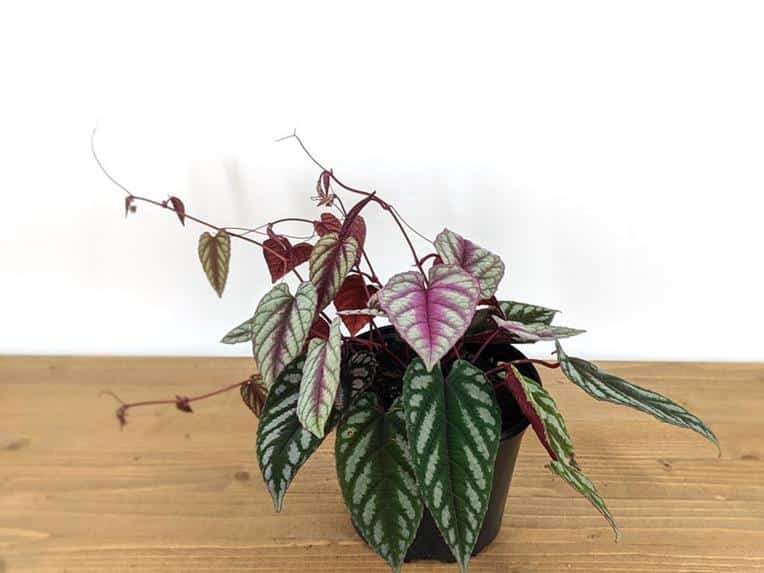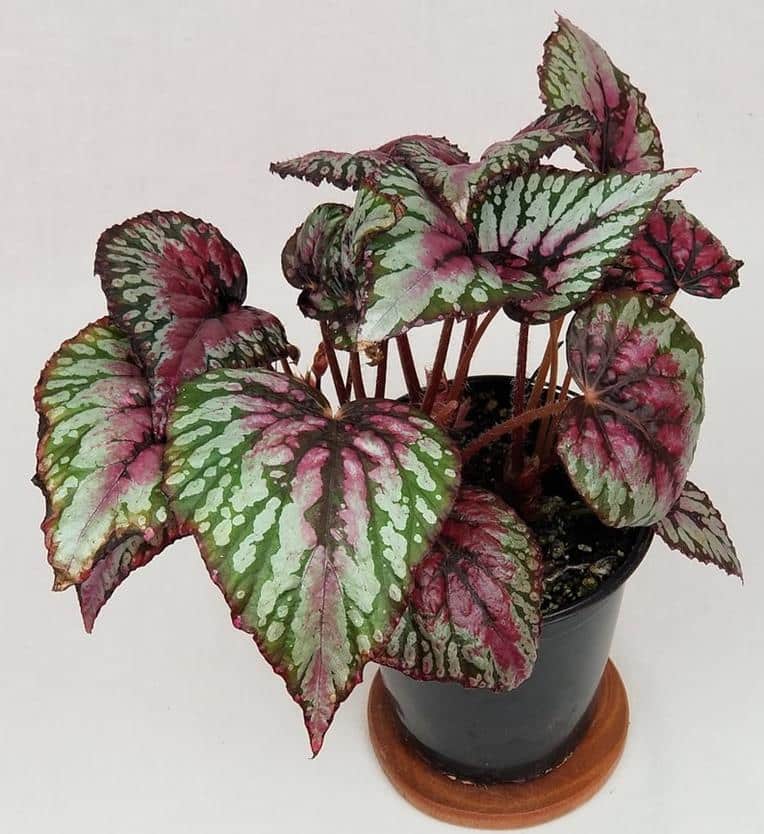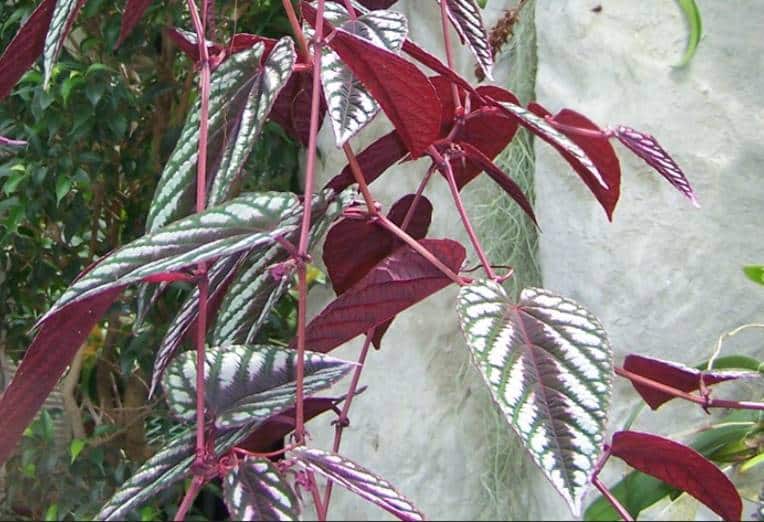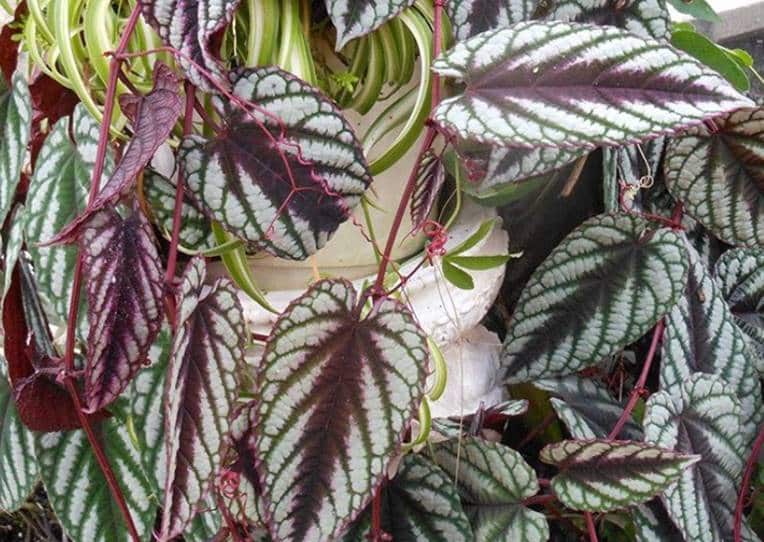The lovely tri-colored leaves of Cissus discolor syn. Cissus javana (rex begonia vine) makes it a must-have adorable houseplant.
Discover Cissus discolor care and growing needs like soil, water, light, humidity, temperature, pruning, etcetera.
We will also look at how to propagate Cissus discolor, diseases and pests, and tell you more about some problems your plant may have, like bumps, curling, yellowing, or falling leaves.

Contents
- Classification
- Quick overview
- How to grow rex begonia vines
- Appearance and identification (with pictures)
- 1. Cissus javana size and growing habits
- 2. Leaves
- 3. Stems and vines
- 4. Cissus javana flower
- Cissus discolor Care and growing requirements
- 1. USDA hardiness zone
- 2. Temperature
- 3. Humidity
- 4. Light
- 5. Soil
- 6. Watering
- a). Overwatered Cissus discolor
- b). Underwatered
- 7. Fertilizer
- 8. Pruning rex begonia vine
- 9. Potting and repotting
- Cissus discolor propagation
- a). What you need
- b). Here is how to propagate Cissus discolor
- c). Propagating in water
- Safety to pets and humans
- Pests
- Diseases and conditions
- 1. Cissus discolor dropping leaves
- 2. Yellowing of leaves
- 3. Root rot
- 4. Curling leaves
- 5. Cissus discolor dying
- 6. Cissus discolor bumps
- FAQs
Classification
Cissus discolor, also known as rex begonia vine, is an evergreen, perennial, flowering trailing plant in the grape or family Vitaceae native to Southeast Asia, especially Java Island and Cambodia. Other houseplants in the family Vitaceae are Cissus alata syn. Cissus rhombifolia or grape ivy, chestnut vine (Tetrastigma voinierianum), and Cissus amazonica.
It is a gorgeous garden and houseplant valued for its elongated heart-shaped, deep green leaves with silvery-white mottling and a deep reddish-purple underside. The foliage somewhat resembles some rex begonia like salsa, hence the name. However, it is not a begonia.

Sometimes, it is known as Cissus Javanabecause it is mainly from java Island (Indonesia). However, it is also native to China, Vietnam, and Thailand.
Quick overview
| Scientific name | Cissus discolor or Cissus javana |
| Family | Vitaceae (grape family) |
| Common names | begonia vine, tapestry vine, climbing begonia |
| Native habitat | Java Island and Cambodia |
| Type | Evergreen. flowering perennial liana or climbing vine |
| Size | 6-8 feet long or more and 0.75 to 1 foot wide. |
| Leaves | 3-6 inches, elongated, heart-shaped, deep green with silvery-white coloration with some burgundy blotch and a deep red underside |
| Flowers | Inconspicuous, yellowish axillary flower clusters |
| Stems | Burgundy or reddish |
| Blooming time | Summer |
| Light requirement | Bright indirect light |
| USDA hardiness zone | 11 or higher |
| Temperature | from 65°F to 80°F, with winters not going below 50°F |
| Humidity | High, but can thrive in moderate, ideally 50% or more |
| Growth rate | Slow growing, takes 3-5 years to mature |
| Soil | Well-drained, nutrient-rich potting mixes |
| Watering | Moderate, after 3-4 times a week, leaving the soil to dry slightly |
| Propagation | Stem cutting |
| Toxicity | Safe for human cats, dogs, and other pets |
| Care level | Moderate |
How to grow rex begonia vines
They make perfect hanging baskets or potted houseplants. You can give them flower poles, trellis, or hoops, or you can let them cascade downwards.
Inside your house, you put them on desks or shelf tops or hang them anywhere, including in your bathroom, office, etc.
Also, you can grow them on mixed borders, let them trail other trees, or anywhere outdoors if your winter temperatures don’t go so low.
Appearance and identification (with pictures)
Before we look at growing requirements and care, let us look at the appearance of this charming houseplant. We will talk about size, leaves, stems, and flowers.
1. Cissus javana size and growing habits
Cissus discolor plant is a relatively fast-growing, herbaceous, climbing vine. It can grow up to 6 to 8 feet high or beyond and spreads about 0.75 to 1 foot wide.
Usually, you will find it in its natural habitat at 1960 and 6500 feet above sea level, in tropical rainforests, climbing on various woody trees.
2. Leaves
Cissus discolor plants have elongated, heart-shaped, velvety leaves about 3 to 6 inches long and 2 to 4 inches wide. They look more like elongated ovate leaves with a cordate base.
The leaves’ upper side is deep green with silvery-white mottling radiating from their center outwards and burgundy blotch along the midrib, veins, and edges, while their underside is deep-reddish purple.

This spectacular coloration makes these plants much sought after since they don’t have very conspicuous flowers.
When touched, the leaves have a raised, velvety feel. Also, note that the leaves have cystoliths, which are small bumps made of calcium carbonate. They serve as some protection from plant-eating animals or insects.
Kindly don’t confuse these cystoliths for disease or conditions. Their occurrence is typical.
3. Stems and vines
Rex begonia vine has reddish stems or vines. Sometimes they may appear burgundy to purplish and bear some resemblance to the underside of the leaves.

They have wispy tendrils for climbing and alternating leaves, which also have reddish petioles.
4. Cissus javana flower
Tapestry vine plant has summer-blooming inconspicuous, bisexual yellow flowers (or pale yellow to greenish). They are less than an inch and grow in clusters from axils (triangular formed by leaf and stem, where a bud may sprout).

In late summer or early fall, rex begonia vine will bear to inedible publish-black, about ¼ inch berries.

Finally, under house growing conditions, this plant will not set seeds or even grow berries. However, in the wild, it is possible.
Cissus discolor Care and growing requirements
Cissus discolor plants require a warm and humid area with indirect, bright light for best foliage variegation. Their water requirement is moderate, ensuring the soil is moist but not soggy or dry. They wilt fast.
There isn’t much difference between Cissus discolor indoor and outdoor care if you meet all requirements below.
Here are care and growing requirements:
1. USDA hardiness zone
Cissus discolor plant grows in USDA hardiness zone 11 with an average minimum temperature range between 40°F and 50°F (4.4°C and 10°C).
People in these areas can grow these plants outdoor all year. However, if the temperature goes below 50 degrees Fahrenheit, please take them indoors.
2. Temperature
The optimum temperature for growing Cissus discolor ranges from 65 to 80 degrees Fahrenheit (about 18° C to 27° C). Therefore, they can thrive well in standard home temperatures.
In Java Island and Cambodia, a typical tapestry vine plant native habitat, the temperature ranges from 70 to 90 degrees Fahrenheit (21°C to 32 °C) and at times slightly higher.
This range confirms to you that these houseplants prefer warmer conditions and can withstand temperatures up to 90 degrees Fahrenheit or even slightly more.
Nevertheless, they are not frost-hardy. Consequently, people who grow rex begonia vine outdoors in cold winters should move these plants indoors.
3. Humidity
Cissus discolor plants prefer high humidity. However, they will thrive well on average household humidity if it isn’t on the lower side. 50% and above will be ok.
Remember that these houseplants grow in Southeast Asia's tropical rainforests, which are warm and humid. Therefore, they will appreciate additional humidity.
We recommend that you have a pebble tray, mist them routinely, or have a humidifier to help raise humidity.
I use LEVOIT Humidifiers Top Fill, 6 Liter, Cool Mist. It runs for up to 60 hours, covers a large area (up to 505 ft square), and is easy to control or fill. Did you know it comes with Vesync APP, and you can connect it to Alexa or Google voice assistant? However, don’t place your plant too close to the humidifier.
When grown in low humidity, your begonia vine may shrivel/wilt, or the leaves may turn yellow, have brown edges, or be crispy and dry. Additionally, the leaves may, at times, fall.
4. Light
Grow your Cissus discolor in bright indirect light but avoid direct sunlight. When grown under lower lighting conditions may not bring out the lovely colorations, especially the silvery ones. Also, they will grow slowly.
On the other hand, avoid direct sunlight as it will burn the very delicate rex begonia leaves. Too much direct light will also cause foliage discoloration (they will look faded).
If the plant is near any window that receives direct sunlight, move it away from the window to a spot where the sunlight cannot reach them.
A north-facing window is probably the best. However, the east or west-facing windows can do if you place your houseplant away from the windowsill.
Even the south-facing window is ok, but ensure no direct sun reaches your houseplant. Play around on where to position your houseplant to avoid direct sunlight.
For those that grow Cissus discolor outdoors outside, go for places with filtered light. Also, a greenhouse or a 40% shade cloth will work well.
5. Soil
The ideal Cissus discolor soil should be well-drained, nutrient-rich, and slightly acid to neutral (pH 6.0 to 7.0), including loamy or sandy soils.
Usually, we use standard houseplant potting mixes like Miracle-Gro Indoor Potting Mix alone. However, to improve drainage, we at times add some 5-10% perlite or pumice. Well-drained soils will minimize the chances of your plant having root rot.
While most potting mixes have peat moss or coconut coir, adding a little more won’t cause much damage. Always look at the label.
Finally, as you pick your potting mix, avoid those with compost or bark as they tend to increase gnat problems.
6. Watering
Cissus discolor need moderate watering, letting soil slightly dry before another session. These houseplants love moist soil, i.e., not so soggy or so dry soil.
Also, water them more frequently during their growing season (spring and summer) and cut the water during winter and fall. However, ensure the potting mix doesn’t dry completely in the non-growing seasons.
How often to water your rex begonia vines depends on how soon the soil dry. Factors such as humidity, air circulation, and temperature will influence how quickly the potting mix dries.
Typically, you will water your rex begonia vine after every 3 to 5 days. A better way to determine whether to water or not is by feeling the soil. Water when the soil feels dry up to the first knuckle of your finger.
Alternatively, buy a soil moisture meter. XLUX is the best brand and highest rated at Amazon. Water when it reads three or less.
Lastly, when watering, soak the soil until excess water comes from the drainage holes.
a). Overwatered Cissus discolor
One of the easiest ways to kill your tapestry vine plant is overwatering it. It will cause root rot which in advanced stages may be irreversible. These plants don’t like sitting in soggy soils.
Besides ever soggy or very wet soils, other signs you are overwatering this vine include the following.
- Yellowing of leaves
- Withering (when root rot sets in)
- Molds on top potting mix
- Mushy stem bases
- Leaves falling
b). Underwatered
While overwatering is detrimental, underwatering is also dangerous because Cissus discolor withers relatively very fast. Signs that this plant is thirsty include:
- Parched potting mix.
- Stunted growth
- Droopy leaves
- Wilting
- Discolored, usually brown crispy leaf tips and edges
7. Fertilizer
These houseplants will benefit from fertilizers. They will help improve growth and ensure your plant is vibrant and lush-looking.
Feed your Cissus discolor with an all-purpose liquid houseplant fertilizer, one after every 3 to 4 weeks during growing seasons (spring and summer). However, don’t fertilize them during winter as they are not growing.
We use Miracle-Gro Water Soluble All Purpose Plant Food, amazon's best seller. With an NPK 24-8-16, this fertilizer has boron, iron, copper, manganese, zinc, and molybdenum. Mix ¼ a teaspoon per gallon of water and use it to water your plant. Apply once after every two weeks.
If you don't prefer feeding your plants frequently, look for a slow-release formula like Jobe's® Houseplant Food Spikes, which you feed once every eight weeks.
Lastly, while lack of nutrients may result in poor or stunted growth, discoloration of leaves and excess fertilizer is detrimental. Signs of excessive fertilizers include the following:
- Wilting and yellowing of leaves
- Brown leaf margins and tips
- Leaves dropping
- Stunted growth
8. Pruning rex begonia vine
Cissus discolor doesn’t require a lot of pruning. Routinely remove any dry, damaged, or dead leaves using sterilized pruning shears or scissors. You don’t want to transmit diseases to your plant with unsterilized scissors.
Additionally, you can prune unkempt, leggy, or very long vines to help maintain the shape you want. However, please don’t overdo it. Also, cutting some of the vines will encourage the growth of more branches and a fuller plant.
9. Potting and repotting
Yes, rex begonia vines are fast growers. However, they don’t require frequent repotting because they have a small, thin, or threadlike root system.
Therefore, repot Cissus discolor every 2 to 3 years and do it during spring or summer (growing season). Nevertheless, if your plant is root bound, repotting may be necessary.
When repotting this houseplant, go for a slightly larger pot, about 2-3 inches larger in diameter. Avoid overly large or deep planters as they will retain moisture for longer, increasing the risks of overwatering and root rot.
Cissus discolor propagation
Cissus discolor is propagated through stem cutting, either in a potting mix or water. Soil works better and faster. However, water allows you to see how the roots are growing.
Nevertheless, some people opt for propagation by layering. This method involves slightly burring the stems (without leaves) in potting mix while still attached to the parent plants.
After some time, they will begin rooting. This method has a very high success rate since the rooting happens while the vine is still getting nutrients from the parent plant.
We will look at stem propagation. Water propagation is similar, with the only difference being the media.
a). What you need
- Potting mix
- Pot
- Sterilized sharp pruning scissors or shears
- Rooting hormone (optional). One of our favorite brands is HydroDynamics Clonex Rooting Gel. It has rooting hormones to help spur new root tissue growth andtrace elements plants require at this stage.
- Pencil or stick
b). Here is how to propagate Cissus discolor
- Select a healthy and mature wood vine and cut it using your pruning scissors, just below a leaf node. Don’t use young vines. They are likely to die.
- Divide the vine into smaller pieces, ensuring each has at least two or three leaves. Remove the lower leaves on each cutting, leaving the upper one or two leaves.
- Dip the cutting in your rooting hormone. It will speed rooting and prevent root rot.
- Poke a hole onto your potting mix with a pencil or stick and plant your cutting, ensuring you bury one node (where you removed a leaf) into the soil and thoroughly water it. Your potting mix should firmly hold your cutting.
- Place your plated cutting in a warm area with bright indirect light. We recommend temperatures of 70 to 75 degrees Fahrenheit (21-24°C) for best growth.
- Make sure the soil remains moist.
Your plant will have roots and begin growing a new bud after a month. These plants root very fast. Once you are satisfied with the growth, transplant it into a growing pot.
Some people prefer covering the cutting transparent plastic bag. It does help hold moisture (reduce the chances of soil drying (maintains humidity). Nevertheless, ensure it has holes to allow some air circulation.
c). Propagating in water
If you opt for propagating Cissus discolor in water, all you need is to dip the cutting in a jar with water. But, replace the water after a few days or when it starts looking cloudy.
When the roots are about 2 inches long, and it has a bud growing, transplant it.
Finally, this method takes slightly longer compared to propagating your plant in a potting mix.
Safety to pets and humans
Cissus discolor is not toxic or poisonous to cats, dogs, and other pets. It is not also harmful or dangerous to humans, making it an excellent choice for people with children and pets.
However, its namesake, the Rex Begonia, which belongs to the family Begoniaceae, is toxic to dogs, cats, horses because it has soluble calcium oxalates. Kindly ensure you don’t confuse these two plants.
Pests
Common pests that affect the rex begonia vine include the whitefly, mealybugs, and red spider mites.
| Pest | Symptoms | Remedy |
| Whitefly | Sticky honeydew on the upper leaf surface that may become sooty or gray, leave yellowing, wilting, loss of vigor, and death if severe | A solution of dish soap and water, neem oil, manually remove eggs using soapy water or rubbing alcohol |
| Mealybugs | Cotton-like wax deposits of leaves, black sooty mounds, stunted growth, leaves yellowing, drying, or falling prematurely, stunted growth | Use rubbing alcohol with a few drops of dishwashing soap, hose your plant (dislodge them), neem oil, sprays with natural pyrethrum, etc. |
| Red spider mites | Dusty webbing, yellow mottling on leaves and leaves drying, yellowing, or falling prematurely | Use diluted liquid dish soap or Insecticidal soaps that contain pyrethroids |
Diseases and conditions
When grown indoors, these ornamental plants are not susceptible to many diseases. However, if you use unsterilized pruning scissors or grow outdoors, they may have leaf spots and powdery mildew.
Powdery mildew will have whitish to gray patches or spots as well as talcum-resembling growth. Use a fungicide.
On the other hand, leaf spot will manifest themselves as black or dark spots on the leaves which begin as water-soaked lesions that quickly turns black. Remove affected leaves and try fungicides such as Patch Pro.
Besides these diseases, other common conditions include the following:
1. Cissus discolor dropping leaves
The most likely reason why your Cissus discolor is dropping leaves is overwatering or underwatering. Also, low humidity may cause this problem or shock.
Shock is when you suddenly change the conditions in which a house plant grows, such as rapid temperature or humidity changes.
Other possible causes include lack of nutrients, poor lighting conditions, pests, or diseases.
2. Yellowing of leaves
If your plant has yellow leaves, you are likely overwatering it. However, it could be due to underwatering, wrong humidity, or light. Additionally, pests, nutrient deficiency, too much fertilizer, and diseases may cause yellowing.
Look at other symptoms such as dry or soggy soil, stunted growth, and so on to help know the exact cause.
3. Root rot
Using pots without drainage holes, poorly draining potting mix or soils, or overwatering your rex begonia vines may cause root rot.
Typical symptoms to expect include:
- Yellowing of leaves
- Wilting
- Stunted growth
- Mushy stems
- Molds growing on the surface of potting mix
4. Curling leaves
Cissus discolor curling leaves is a sign of low moisture, especially if the leaves look limp or wilted. However, pests damage, very high temperatures, or too much direct sunlight may cause it.
5. Cissus discolor dying
A dying Cissus discolor is an indication that some of the growing required growing conditions are unmet.
Also, your plant may be dying due to root rot, excessive fertilizer, nutritional deficiencies, disease or it is heavily infested with pests.
To help save or revive your plant, look at each of the growing requirements we have provided and ensure you provide them.
However, in some cases, especially severe root rot, you may not salvage your plant, no matter what you do.
6. Cissus discolor bumps
If you notice small bumps on your Cissus discolor plant, they are likely insects or mite galls. See the image below.

These are small bumps or growths formed in response feeding or laying of eggs by insects or mites.
To prevent them, get rid of any insects or mites on your plant. You can use insecticidal soaps, remove affected leaves, wash them with dish soap/water mixture, rubbing alcohol, and on. The exact approach depends on which insects or mites are responsible.
If there are no insects, it is possible to form galls due to viruses, bacteria, or fungi.
FAQs
Probably, you still have tons of questions. Here are some Frequently asked questions that may help.
No. Cissus discolor is not a begonia. They are known as rex begonia vine because it resembles Rex begonia. However, these two plants belong to different families, i.e., Vitaceae (grapes) and Begoniaceae.
No. It is not a very rare plant as you can find it on sale at Etsy.com, Walmart, and many other places. However, it is not one of the commonly available houseplants.





Leave a Reply